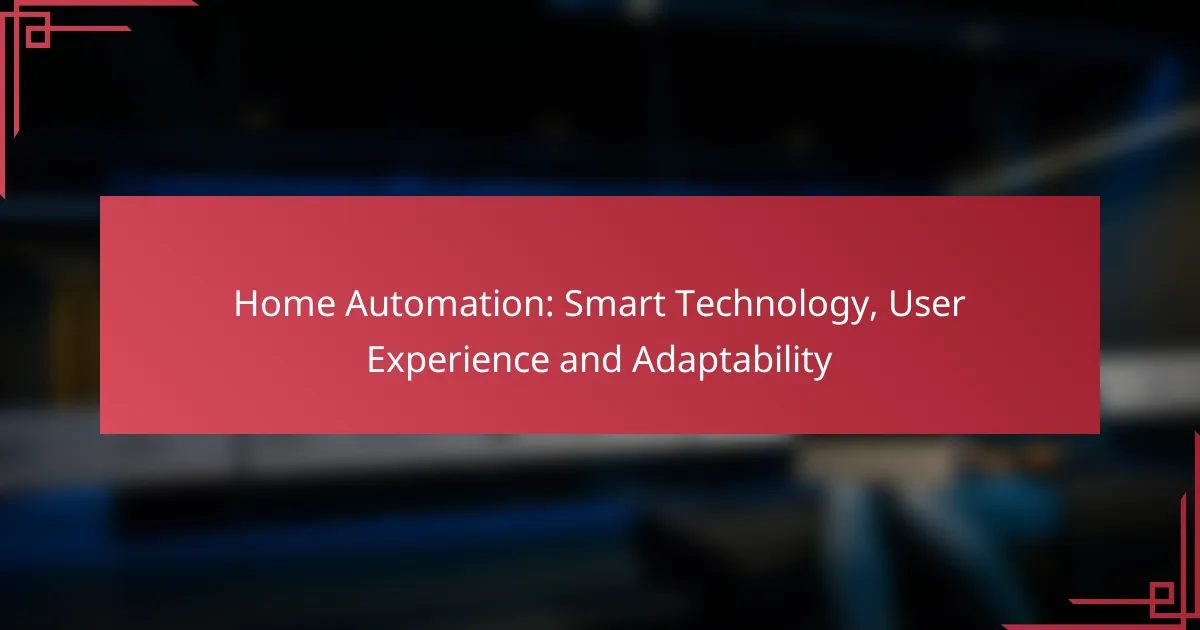Home automation powered by AI is revolutionizing the way we interact with our living spaces, offering enhanced efficiency, security, and personalized experiences. By learning user preferences and automating tasks, these smart systems not only increase convenience but also promote energy savings. As platforms like Google Nest, Amazon Alexa, and Apple HomeKit gain popularity, homeowners can enjoy a seamless integration of technology into their daily lives.

What are the benefits of AI integration in home automation?
AI integration in home automation offers numerous advantages, including enhanced efficiency, improved security, and personalized experiences. By utilizing AI, smart home systems can learn user preferences and optimize operations, leading to significant benefits for homeowners.
Enhanced energy efficiency
AI-driven home automation systems can significantly improve energy efficiency by analyzing usage patterns and adjusting settings accordingly. For example, smart thermostats can learn when occupants are home or away and optimize heating and cooling schedules to reduce energy consumption.
Homeowners can expect energy savings of around 10-30% with the implementation of AI technologies. Additionally, integrating AI with smart lighting can ensure lights are only on when needed, further contributing to lower energy bills.
Improved security features
AI enhances home security by providing real-time monitoring and intelligent alerts. Smart cameras equipped with AI can differentiate between familiar faces and strangers, reducing false alarms and allowing for quicker responses to potential threats.
Moreover, AI systems can analyze data from various sensors to detect unusual activity patterns, alerting homeowners to potential security breaches before they escalate. This proactive approach can lead to a safer living environment.
Convenience and remote access
AI integration allows homeowners to control their smart devices remotely, providing unparalleled convenience. Users can manage lighting, heating, and security systems from their smartphones, enabling them to make adjustments from anywhere.
This remote access is particularly beneficial for busy individuals or those who travel frequently, as it allows for real-time monitoring and control of home systems. Voice-activated assistants further enhance convenience by enabling hands-free operation of various devices.
Personalized user experiences
AI systems can create personalized experiences by learning individual preferences and habits. For instance, smart speakers can curate playlists based on listening history, while smart kitchens can suggest recipes based on available ingredients.
This level of customization not only enhances user satisfaction but also encourages more efficient use of home resources. Homeowners can enjoy a tailored environment that adapts to their lifestyle and needs.
Cost savings over time
While the initial investment in AI home automation can be significant, the long-term cost savings often outweigh these expenses. Energy efficiency improvements and reduced utility bills can lead to substantial savings over time.
Additionally, enhanced security features can help prevent costly theft or damage, further contributing to overall savings. Homeowners should consider the return on investment when evaluating AI integration for their homes.

How does AI improve smart home devices?
AI enhances smart home devices by enabling them to learn from user interactions, adapt to preferences, and automate tasks. This integration results in increased convenience, energy efficiency, and personalized experiences for homeowners.
Machine learning algorithms
Machine learning algorithms allow smart home devices to analyze data patterns and improve their performance over time. For instance, a smart thermostat can learn your heating preferences and adjust settings accordingly, leading to energy savings of around 10-20% on heating bills.
These algorithms can also optimize device interactions, such as coordinating multiple devices to work together seamlessly. When selecting devices, look for those that use advanced machine learning techniques for better adaptability.
Voice recognition capabilities
Voice recognition capabilities enable users to control smart home devices through spoken commands, enhancing accessibility and user experience. Devices equipped with this technology can understand natural language, allowing for more intuitive interactions.
For example, smart speakers can execute commands like “dim the lights” or “play music” without requiring specific phrasing. When choosing voice-activated devices, ensure they support multiple languages and dialects for broader usability.
Predictive analytics for user behavior
Predictive analytics helps smart home devices anticipate user needs based on historical data. This means that a smart lighting system might automatically adjust brightness levels based on the time of day and previous user behavior.
By leveraging predictive analytics, devices can enhance energy efficiency and improve comfort. When implementing such systems, consider those that offer customizable settings to fine-tune predictions to your lifestyle.

What are popular AI home automation systems in Ireland?
In Ireland, popular AI home automation systems include Google Nest, Amazon Alexa, and Apple HomeKit. These platforms offer various features for controlling smart devices, enhancing convenience, and improving energy efficiency in homes.
Google Nest
Google Nest integrates seamlessly with a range of smart home devices, allowing users to control lighting, heating, and security systems through voice commands or a mobile app. Its compatibility with Google Assistant enables users to manage their home environment easily.
Consider the Google Nest Hub, which acts as a central control panel for all connected devices. It also provides visual feedback, such as displaying camera feeds or weather updates. Users should ensure their devices are compatible with the Google ecosystem for optimal performance.
Amazon Alexa
Amazon Alexa is another leading AI home automation system, known for its extensive compatibility with third-party devices. Users can control smart home gadgets, play music, and access information through voice commands using Echo devices.
One of the key advantages of Alexa is its ability to create routines, allowing multiple actions to be triggered with a single command. For instance, saying “Goodnight” can turn off lights, lock doors, and adjust the thermostat. Users should be mindful of privacy settings, as Alexa devices are always listening for commands.
Apple HomeKit
Apple HomeKit offers a secure and user-friendly platform for automating smart home devices, particularly for those already using Apple products. It allows users to control devices via the Home app or Siri, ensuring a cohesive experience across Apple devices.
HomeKit emphasizes security and privacy, using end-to-end encryption for data transmission. Users should check for the “Works with Apple HomeKit” label when purchasing devices to ensure compatibility. Additionally, HomeKit users can set up automations based on their location or time of day, enhancing convenience and energy efficiency.

What factors should you consider when choosing a home automation system?
When selecting a home automation system, consider compatibility with existing devices, ease of use and installation, and the level of customer support available. These factors will significantly influence your overall experience and satisfaction with the system.
Compatibility with existing devices
Ensure the home automation system you choose is compatible with your current devices, such as smart lights, thermostats, and security cameras. Look for systems that support popular protocols like Zigbee, Z-Wave, or Wi-Fi to maximize integration options.
Check for compatibility lists on the manufacturer’s website or user forums to confirm that your devices will work seamlessly. This step can save you from investing in a system that may not support your existing technology.
Ease of use and installation
Choose a home automation system that is user-friendly and straightforward to install. Systems that offer mobile apps with intuitive interfaces can significantly enhance your experience, allowing for easy setup and control.
Consider whether the installation requires professional help or if it can be done independently. Many systems offer plug-and-play options, which can be set up in less than an hour, while others may require more complex configurations.
Customer support and community
Evaluate the level of customer support provided by the manufacturer, including availability of live chat, phone support, and online resources. A responsive support team can help resolve issues quickly and enhance your overall satisfaction.
Additionally, check for active online communities or forums where users share tips and solutions. Engaging with a community can provide valuable insights and troubleshooting assistance, making your home automation journey smoother.

What are the future trends in home automation?
The future of home automation is marked by enhanced connectivity, smarter technologies, and a growing emphasis on environmental responsibility. These trends are reshaping how consumers interact with their homes, leading to increased convenience and efficiency.
Increased integration with IoT
Home automation is increasingly leveraging the Internet of Things (IoT) to create interconnected devices that communicate seamlessly. This integration allows homeowners to control lighting, security systems, and appliances from a single platform, often via smartphones or voice assistants.
As IoT devices proliferate, consumers can expect more compatibility among brands and products. For example, a smart thermostat can adjust heating based on data from smart blinds that detect sunlight, optimizing energy use and comfort.
Advancements in AI technologies
Artificial intelligence is playing a crucial role in the evolution of home automation, enabling systems to learn user preferences and automate tasks accordingly. Smart assistants can now analyze patterns in daily routines to suggest energy-saving measures or remind users of maintenance tasks.
For instance, AI-driven security cameras can distinguish between familiar faces and strangers, reducing false alarms and enhancing home safety. As AI technology advances, these systems will become even more intuitive and responsive to individual needs.
Focus on sustainability
With growing awareness of environmental issues, the home automation industry is prioritizing sustainability. Smart home systems can help reduce energy consumption by optimizing usage based on real-time data and user habits.
Homeowners can invest in energy-efficient devices, such as smart thermostats and LED lighting, which not only lower utility bills but also contribute to a smaller carbon footprint. Additionally, many new automation solutions are designed to integrate with renewable energy sources, such as solar panels, further promoting eco-friendly living.



